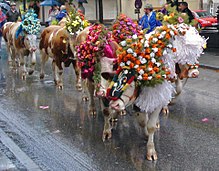Kufstein
The municipal arrangement comprises the cadastral communities of Kufstein, Morsbach and Thierberg; the town itself is divided into five quarters (Zentrum, Sparchen, Weissach, Endach, and Zell).
The Festungsbahn is a funicular that links the city center with the Kufstein Fortress Archaeological findings in the Tischofer Cave in Kaisertal denote a settlement of the area more than 30,000 years ago, the oldest traces of human habitation in Tyrol.
At that time, the Lower Inn Valley was part of the Bavarian realm under the Agilolfing duke Tassilo III, who was deposed by Charlemagne and replaced by Prefect Gerold.
Duke Stephen III of Bavaria granted Kufstein city status in 1393, due to its prominence as a trading and docking point on the Inn River.
During the War of the Spanish Succession, the castle was again besieged by Bavarian troops under Elector Maximilian II Emanuel in 1703, nevertheless the Austrian domains were confirmed by the Treaty of Ilbersheim the next year.
After the War of the Third Coalition, Kufstein once again was awarded to the newly established Kingdom of Bavaria in the 1805 Peace of Pressburg and the Tyrolean Rebellion of 1809 was crushed by the Bavarian Army.
In the 19th century, Kufstein Fortress was turned into a bastille for political prisoners, such as the Hungarian outlaw Sándor Rózsa, who spent several years here before he was finally pardoned in 1868.







